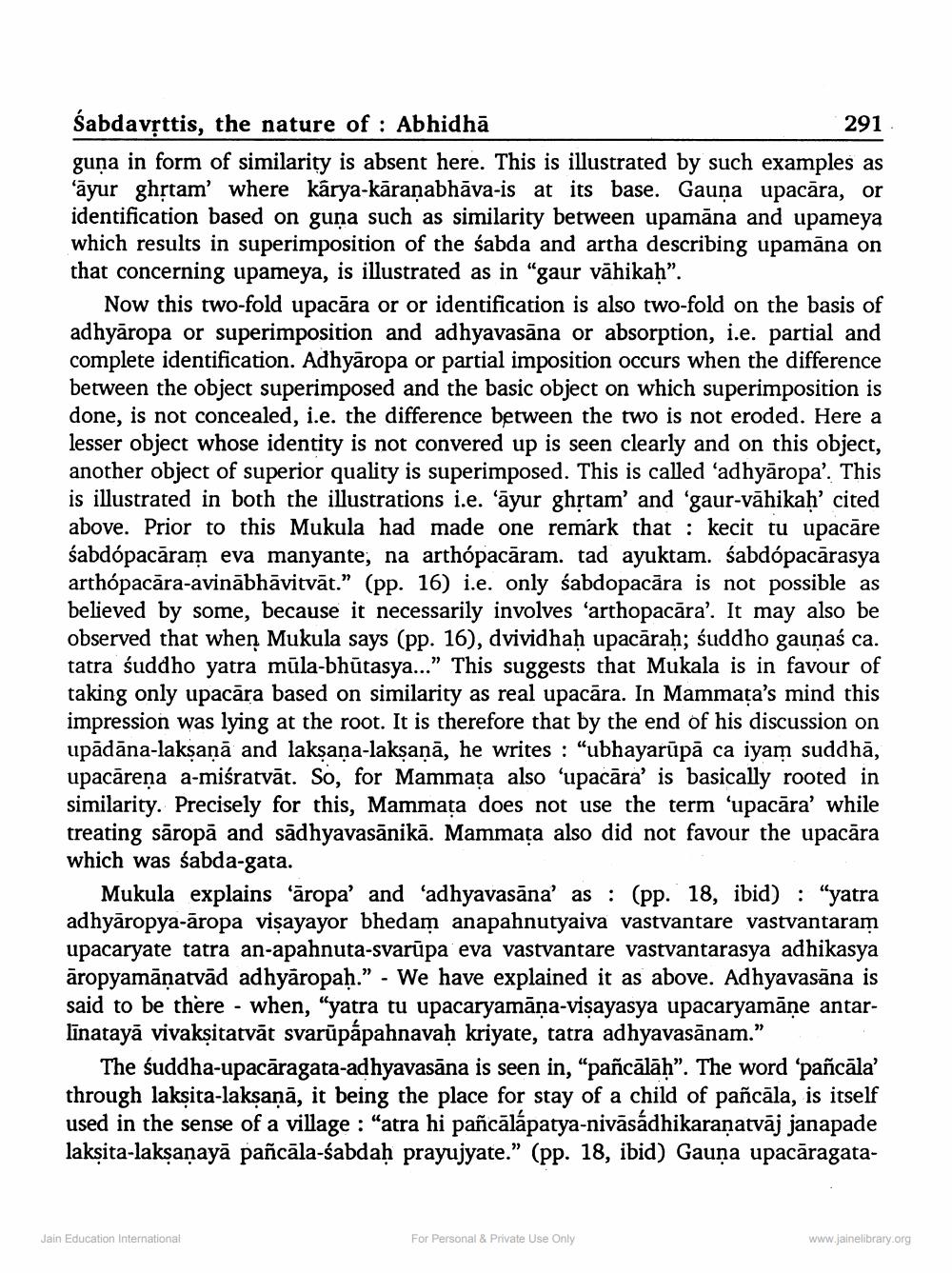________________
Sabdavrttis, the nature of : Abhidhā
291
guna in form of similarity is absent here. This is illustrated by such examples as ayur ghrtam' where karya-karanabhāva-is at its base. Gauna upacara, or identification based on guna such as similarity between upamāna and upameya which results in superimposition of the sabda and artha describing upamāna on that concerning upameya, is illustrated as in "gaur vāhikah".
Now this two-fold upacāra or or identification is also two-fold on the basis of adhyāropa or superimposition and adhyavasāna or absorption, i.e. partial and complete identification. Adhyāropa or partial imposition occurs when the difference between the object superimposed and the basic object on which superimposition is done, is not concealed, i.e. the difference between the two is not eroded. Here a lesser object whose identity is not convered up is seen clearly and on this object, another object of superior quality is superimposed. This is called 'adhyāropa'. This is illustrated in both the illustrations i.e. ayur ghrtam' and 'gaur-vāhikah' cited above. Prior to this Mukula had made one remark that : kecit tu upacāre śabdópacāram eva manyante; na arthópacāram. tad ayuktam. śabdópacārasya arthópacāra-avinābhāvitvāt.” (pp. 16) i.e. only śabdopacăra is not possible as believed by some, because it necessarily involves 'arthopacāra'. It may also be observed that when Mukula says (pp. 16), dvividhaḥ upacāraḥ; śuddho gaunaś ca. tatra suddho yatra mūla-bhūtasya..." This suggests that Mukala is in favour of taking only upacara based on similarity as real upacāra. In Mammata's mind this impression was lying at the root. It is therefore that by the end of his discussion on upādāna-laksaņā and laksana-laksanā, he writes : "ubhayarūpā ca iyam suddhā, upacarena a-miśratvāt. So, for Mammața also 'upacāra' is basically rooted in similarity. Precisely for this, Mammața does not use the term 'upacāra' while treating sāropā and sādhyavasānikā. Mammata also did not favour the upacara which was sabda-gata.
Mukula explains 'āropa' and 'adhyavasāna' as : (pp. 18, ibid) : “yatra adhyāropya-āropa visayayor bhedam anapahnutyaiva vastvantare vastvantaram
tatra an-apahnuta-svarūpa eva vastvantare vastvantarasya adhikasya āropyamāṇatvād adhyāropah.” - We have explained it as above. Adhyavasāna is said to be there - when, "yatra tu upacaryamāņa-visayasya upacaryamāṇe antarlīnatayā vivakṣitatvāt svarūpápahnavaḥ kriyate, tatra adhyavasānam.”
The suddha-upacāragata-adhyavasāna is seen in, “pañcālāḥ”. The word 'pañcāla' through lakṣita-lakṣaṇā, it being the place for stay of a child of pañcāla, is itself used in the sense of a village : "atra hi pañcālápatya-nivāsádhikaranatvāj janapade lakṣita-laksanayā pañcāla-śabdaḥ prayujyate.” (pp. 18, ibid) Gauņa upacāragata
Jain Education International
For Personal & Private Use Only
www.jainelibrary.org




